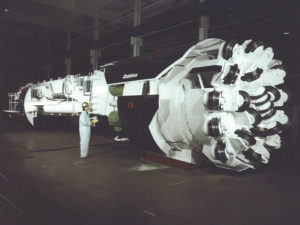![65 Years of Innovation and Experience [default]](https://www.robbinstbm.com/wp-content/uploads/2017/04/Side-Bar-Blue-Blocks_70-Years.jpg)
A Solution for Every Condition: Search our Project Database
Project Map
FEATURED PRODUCT: CROSSOVER MACHINES
Our History
A Legacy of Innovation
Information 24/7
News & Media
Insights in the Industry:
Read the Robbins Blog
 The Meråker Project consists of a system of power stations and underground tunnels that increase the electrical output supplying a local smelter and surrounding areas. Three lakes and several rivers supply 44 km (27.3 mi) of tunnels that feed into a generating facility in Tevla. From Tevla, a combined headrace/tailrace tunnel carries the water to the power station at Meråker.
The Meråker Project consists of a system of power stations and underground tunnels that increase the electrical output supplying a local smelter and surrounding areas. Three lakes and several rivers supply 44 km (27.3 mi) of tunnels that feed into a generating facility in Tevla. From Tevla, a combined headrace/tailrace tunnel carries the water to the power station at Meråker.
Merkraft, a joint venture of Eeg Henriksem Anlegg a/s and a/s Veidekke, chose a Robbins 3.5 m (11.5 ft) diameter Main Beam tunnel boring machine (TBM) to bore 10 km (6.2 mi) of tunnel at Meråker. The remaining sections of tunnel were excavated by drill and blast.
Rocks along the tunnel path consist of Cambrian and Ordovician metamorphic sediments with meta gabbro intrusions. In all, six different rock types exist along the tunnel route. These rocks include relatively soft phyllite; mixed face rocks such as greywacke and sandstone; and hard meta gabbro.
Robbins built the Main Beam TBM to successfully bore through varying rock conditions—from hard to mixed face. The machine featured four 335 kW (459 hp) motors and 25 front-loading disc cutters 19 inches (483 mm) in diameter. The TBM had cutterhead power of 1,340 kW (1,836 hp) and a maximum cutterhead thrust of 10,291 kN (2,313,531 lb).
The High-Power TBM was a stronger, more durable TBM than its predecessors. It was one of the first TBMs of a line that Robbins developed to withstand higher loads. These machines ushered in the new generation of TBMs with features such as triple axle main bearings and cutterhead modifications to improve boring efficiency at high thrust.
The TBM began boring at an impressive rate in September 1991. In its first full month of boring, the TBM excavated 1,029 m (3,376 ft). Soon after, the machine set a Norwegian tunneling record of 395 m (1,295 ft) during the week of October 28-November 3, 1991. During the course of the drive, the TBM reached rates of penetration up to 10 m (32.8 ft) per hour. Its average rate of penetration was 6 m (21 ft) per hour or 253 m (830 ft) per week. The machine’s best day was 100 m (329 ft), its best week was 427 m (1,400 ft), and its best month was 1,358 m (4,455 ft). The TBM accomplished these high advance rates despite Norwegian regulations limiting underground construction projects to 100 shifts per week.
In 1992 the TBM finished the 10 km (6.2 mi) tunnel six months ahead of schedule. The early completion allowed workers to finish all 44 km (27.3 mi) of tunnel in late 1992.

 Close
Close